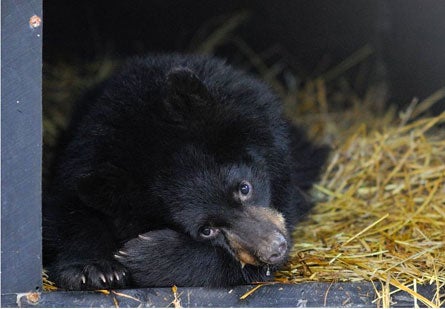The Science of Bear Hibernation

It’s no secret that bears hibernate in winter—so it’s a little surprising how little we know about it. A new study by Øivind Tøien of the University of Alaska-Fairbanks sheds a little light on bear dens in winter, and it turns out what’s going on with a bear’s body is way more complex than just passing out. The results could even lead to innovations in medical treatment.
Tøien and his team took five Alaskan problem black bears and provided them with artificial dens far into the woods—so far Tøien had to ski out to collect the data. The bears were fitted with sensors to capture temperature and heart rate, and researchers outfitted dens with infrared cameras and other sensors to monitor the bears’ movement, oxygen consumption, and even their snoring. (Watch it here.)
After five months of watching snoring bears, the scientists ended up with some interesting findings. While most hibernating animals’ temperature drops to just above freezing, bears keep theirs around 6 degrees Celsius. While sleeping, they conserve energy by taking one to two breaths per minute; their hearts flutter briefly when they breath and then stop, reducing heartbeats to four per minute. Oxygen and metabolic consumption drops by 75 percent, and bears prep for this by wandering around and eating like normal for a few weeks before hibernation, but with a lowered metabolic rate so they can store more energy than they consume.
What does this mean for people? Scientists think that with extended study it may enable us to slow metabolic rates for accident victims, extending a “golden hour” treatment window into a “golden week.” Lowered metabolism in humans with heart ailments could enable them to lead a more active life.
And don’t forget the sci-fi implications: Yes, the scientists admit that it offers insight into how humans might replicate a hibernating state for long-distance space travel. But that’s a long way off. Plenty of mysteries remain, like how bears retain bone and muscle mass, and how their brain survives with such little oxygen without incurring any damage.
—Ted Alvarez
Science